英语教案表格
- 格式:doc
- 大小:15.00 KB
- 文档页数:3

英语备课教案表格As an English lesson plan designer, I am going to provide a comprehensive English lesson plan template in this document. This template aims to assist teachers in organizing their lessons effectively and efficiently. By following this template, teachers can ensure that all necessary components are included in their lesson plans, leading to a well-structured and engaging classroom experience for students.1. Lesson Information:Lesson Title: Introducing Vocabulary for Daily Routines。
Grade Level: 5th Grade。
Duration: 45 minutes。
Subject: English。
Lesson Context: This lesson is part of a unit on daily routines. Students have already learned basic vocabulary related to daily activities and are now ready to expand their vocabulary in this area.2. Lesson Objectives:By the end of the lesson, students will be able to:Identify and understand new vocabulary related to daily routines.Use the new vocabulary in context to describe their own daily routines.Demonstrate comprehension of the new vocabulary through various activities.3. Materials:Flashcards with pictures of daily routine activities.Whiteboard and markers.Worksheets with fill-in-the-blank exercises.Real-life pictures depicting different daily routines.Interactive online resources for vocabulary practice (optional).4. Warm-up (5 minutes):Greet the students and review the previously learned vocabulary related to daily routines.Engage students in a quick discussion about their morning routines, encouraging them to use the vocabulary words they have already learned.5. Introduction of New Vocabulary (10 minutes):Present flashcards with new vocabulary words, such as "brush teeth," "take a shower," "eat breakfast," etc.Pronounce each word clearly and have students repeat after you to practice pronunciation.Show real-life pictures depicting different daily routines and ask students to match the pictures with the corresponding vocabulary words.6. Vocabulary Practice (15 minutes):Divide the class into pairs or small groups.Distribute worksheets with fill-in-the-blank exercises, where students need to complete sentences using the new vocabulary words.Monitor and provide assistance as needed.Review the answers as a whole class, allowing students to correct their own work.7. Application and Consolidation (10 minutes):Ask students to work in pairs again.Provide them with a scenario, such as planning a day out, and ask them to create a dialogue using the new vocabulary words.Encourage students to be creative and use the vocabulary words in context.Select a few pairs to perform their dialogues in front of the class.8. Wrap-up and Assessment (5 minutes):Review the new vocabulary words as a whole class.Ask students to write a short paragraph describing their own daily routines using the new vocabulary words.Collect the paragraphs for assessment purposes.9. Extension Activities (optional):Assign an online vocabulary game for students to practice the new words at home.Encourage students to create flashcards or posters with the new vocabulary words and display them in the classroom.By following this English lesson plan template, teachers can ensure that their lessons are well-structured and cover all necessary components. This template provides a clear framework for introducing new vocabulary, practicing it in context, and assessing students' understanding. Additionally, the suggested extension activities allow for further practice and reinforcement of the new vocabulary. With this comprehensive lesson plan template, teachers can create engaging and effective English lessons for their students.。
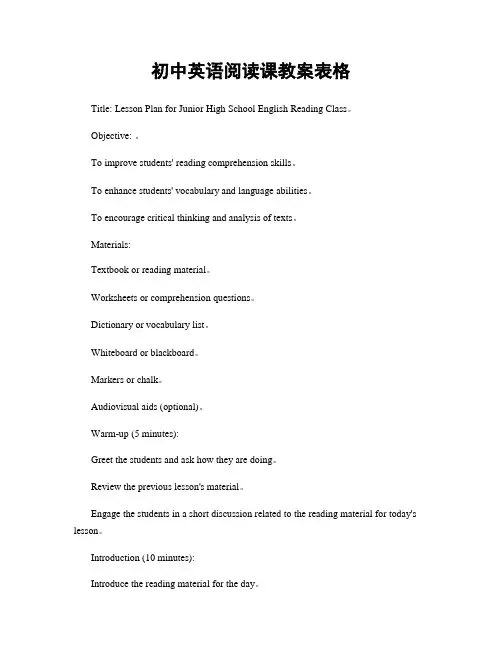
初中英语阅读课教案表格Title: Lesson Plan for Junior High School English Reading Class。
Objective: 。
To improve students' reading comprehension skills。
To enhance students' vocabulary and language abilities。
To encourage critical thinking and analysis of texts。
Materials:Textbook or reading material。
Worksheets or comprehension questions。
Dictionary or vocabulary list。
Whiteboard or blackboard。
Markers or chalk。
Audiovisual aids (optional)。
Warm-up (5 minutes):Greet the students and ask how they are doing。
Review the previous lesson's material。
Engage the students in a short discussion related to the reading material for today's lesson。
Introduction (10 minutes):Introduce the reading material for the day。
Provide some background information about the author or the context of the text。
Discuss any difficult vocabulary words and their meanings。
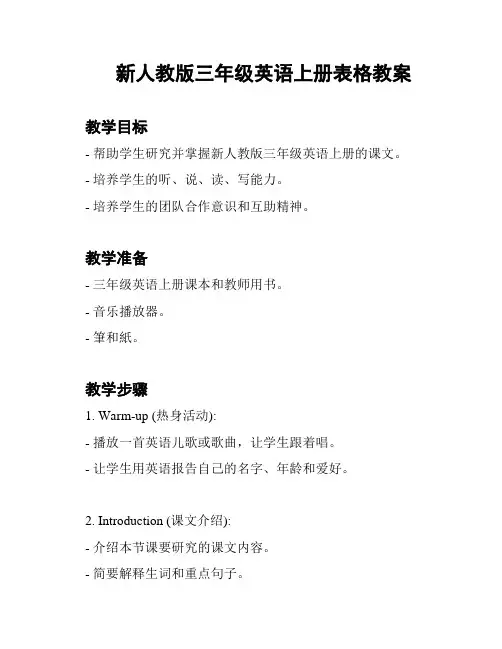
新人教版三年级英语上册表格教案教学目标- 帮助学生研究并掌握新人教版三年级英语上册的课文。
- 培养学生的听、说、读、写能力。
- 培养学生的团队合作意识和互助精神。
教学准备- 三年级英语上册课本和教师用书。
- 音乐播放器。
- 筆和紙。
教学步骤1. Warm-up (热身活动):- 播放一首英语儿歌或歌曲,让学生跟着唱。
- 让学生用英语报告自己的名字、年龄和爱好。
2. Introduction (课文介绍):- 介绍本节课要研究的课文内容。
- 简要解释生词和重点句子。
3. Listening (听力训练):- 播放课文录音。
- 学生跟读课文,加强对课文内容的理解。
4. Reading (阅读训练):- 学生分组读课文,帮助他们提高阅读理解能力。
- 教师带领学生朗读课文。
5. Vocabulary (词汇研究):- 教师介绍本课文中的重点词汇,并帮助学生记忆和理解。
6. Speaking (口语练):- 学生根据课文内容,进行问答练。
- 学生分组进行对话练,展示他们的口语表达能力。
7. Writing (书写训练):- 学生用英语写下自己的名字、年龄和爱好,并和同学分享。
8. Consolidation (巩固训练):- 教师与学生一起回顾本节课的重点内容。
- 学生进行小组活动,练对话或口头应答。
9. Conclusion (课堂总结):- 教师总结本节课的研究内容,并提出问题检查学生的掌握情况。
- 学生回答问题,巩固和复所学知识。
10. Homework (家庭作业):- 布置适当的书写或口语练作业。
- 提醒学生预下节课的内容。
教学评价- 观察学生在课堂上的听、说、读、写表现。
- 对学生的课堂参与情况进行评价。
- 根据学生的作业完成情况评价其独立研究能力。
- 针对学生的表现给予适当的鼓励和指导。
以上是新人教版三年级英语上册表格教案的概要,请根据具体情况进行具体操作和调整。
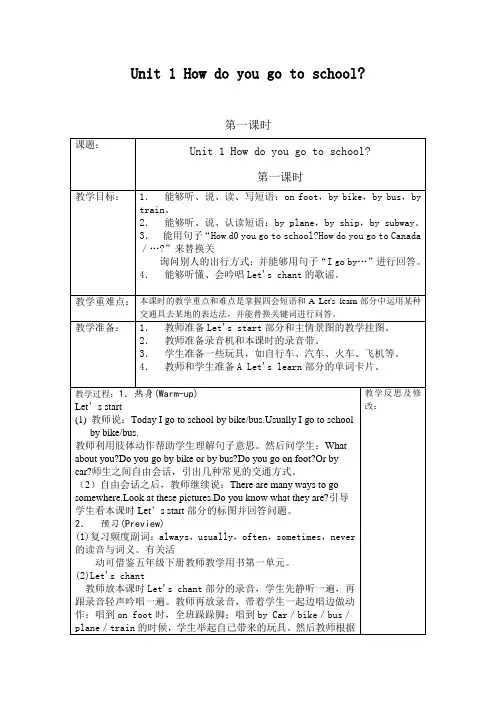
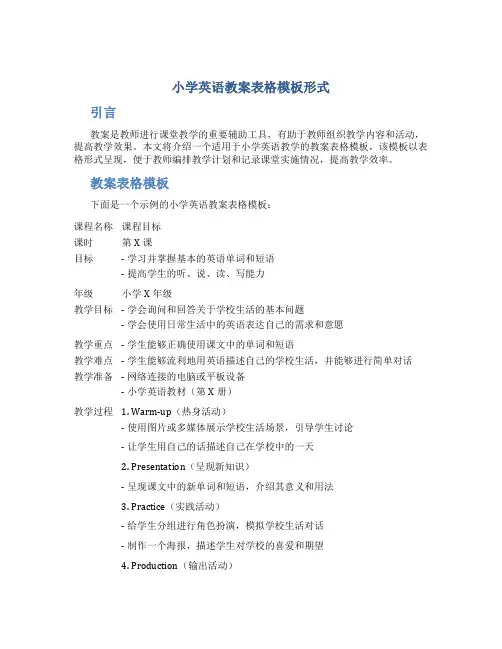
小学英语教案表格模板形式引言教案是教师进行课堂教学的重要辅助工具,有助于教师组织教学内容和活动,提高教学效果。
本文将介绍一个适用于小学英语教学的教案表格模板,该模板以表格形式呈现,便于教师编排教学计划和记录课堂实施情况,提高教学效率。
教案表格模板下面是一个示例的小学英语教案表格模板:课程名称课程目标课时第X课目标- 学习并掌握基本的英语单词和短语- 提高学生的听、说、读、写能力年级小学X年级教学目标- 学会询问和回答关于学校生活的基本问题- 学会使用日常生活中的英语表达自己的需求和意愿教学重点- 学生能够正确使用课文中的单词和短语教学难点- 学生能够流利地用英语描述自己的学校生活,并能够进行简单对话教学准备- 网络连接的电脑或平板设备- 小学英语教材(第X册)教学过程 1. Warm-up(热身活动)- 使用图片或多媒体展示学校生活场景,引导学生讨论- 让学生用自己的话描述自己在学校中的一天2. Presentation(呈现新知识)- 呈现课文中的新单词和短语,介绍其意义和用法3. Practice(实践活动)- 给学生分组进行角色扮演,模拟学校生活对话- 制作一个海报,描述学生对学校的喜爱和期望4. Production(输出活动)- 让学生编写一个关于学校生活的短文5. Summary(总结)- 教师总结本节课的学习内容和教学重点6. Homework(作业)- 布置课后作业,复习本节课学到的内容,并写一段对话教学评价- 教师观察学生在实践活动中的表现,评价学生的口语表达能力- 教师批改学生的编写的短文,评价学生的书写能力- 同学之间互相评价彼此的海报和对话- 教师记录学生在课堂上的参与度和学习情况反思- 教师反思本节课的教学过程和学生学习效果结论教案表格模板以表格形式清晰、简洁地呈现了小学英语教学的课程目标、教学过程和教学评价。
教师可以根据自己的教学需要进行调整和修改,以便更好地组织课堂教学活动,提高学生的英语学习效果和兴趣。
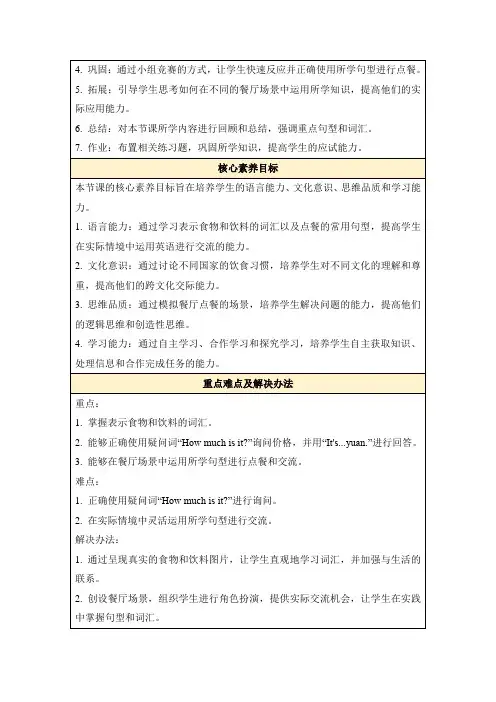
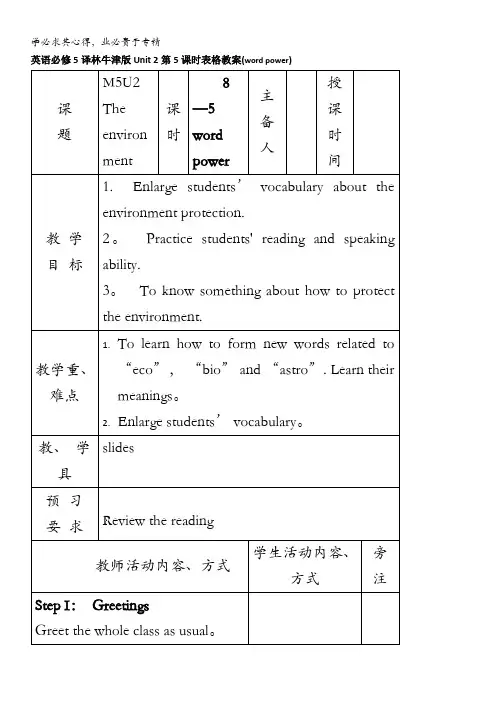
英语必修5译林牛津版Unit 2第5课时表格教案(word power)高考链接-拓展阅读So much to do, so little time。
So much infonnation, so little time to read it。
In this age there is more information than ever before. There is not enough time to read everything wewant to read. However, you can consume more information in shorter time through speed—reading。
This article will not makeyou read 3,000 words per minute,but it will show you how to increase your speed significantly。
You will also learn the basictechniques of speed-reading, along with the dos and don' ts of speed —reading.When you first learned to read, you would say the word out loud and sound it out。
Then you might whisper the word because people can become annoyed when you read aloud。
The stage you are now at is saying the word in your head。
Most people tend to read this way。
Saying the word in your head will cut your reading speed tremendously (极大地)。
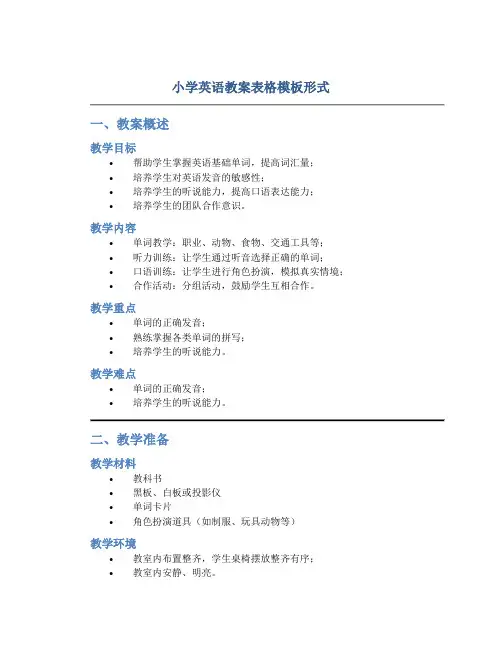
小学英语教案表格模板形式一、教案概述教学目标•帮助学生掌握英语基础单词,提高词汇量;•培养学生对英语发音的敏感性;•培养学生的听说能力,提高口语表达能力;•培养学生的团队合作意识。
教学内容•单词教学:职业、动物、食物、交通工具等;•听力训练:让学生通过听音选择正确的单词;•口语训练:让学生进行角色扮演,模拟真实情境;•合作活动:分组活动,鼓励学生互相合作。
教学重点•单词的正确发音;•熟练掌握各类单词的拼写;•培养学生的听说能力。
教学难点•单词的正确发音;•培养学生的听说能力。
二、教学准备教学材料•教科书•黑板、白板或投影仪•单词卡片•角色扮演道具(如制服、玩具动物等)教学环境•教室内布置整齐,学生桌椅摆放整齐有序;•教室内安静、明亮。
三、教学过程步骤一:导入新课1.教师与学生互动打招呼,创设轻松、活跃的氛围。
2.教师出示一些单词卡片,让学生猜测单词的意思,引起学生的兴趣。
步骤二:呈现新课1.教师出示新课的词汇表格,带领学生逐个学习新单词的发音。
2.教师逐个解释单词的意思,示范正确的发音方式,学生跟读。
步骤三:单词练习1.教师将学生分为小组,每个小组轮流出示一张单词卡片,其他小组根据发音猜测单词的意思。
2.学生逐个发言,教师进行纠正和点评。
步骤四:听力训练1.教师播放一段录音,内容与课堂学习的单词相关。
2.学生听录音,选择与所听内容相关的单词,标注在词汇表格上。
3.教师核对答案,引导学生订正错误,并解释正确答案的依据。
步骤五:口语训练1.教师将学生分为小组,每个小组分配一个角色,如服务员、顾客、医生、病人等。
2.学生在角色扮演中进行对话,运用课堂学到的单词进行交流。
3.教师轮流巡视各组,给予指导和点评。
步骤六:合作活动1.教师将学生分为小组,每个小组分配一个任务,如制作一张职业卡片集合,包含不同职业的图片和单词。
2.学生在小组内讨论、设计,并分工合作完成任务。
3.教师适时提供帮助和指导,鼓励学生发挥想象力,充分合作。

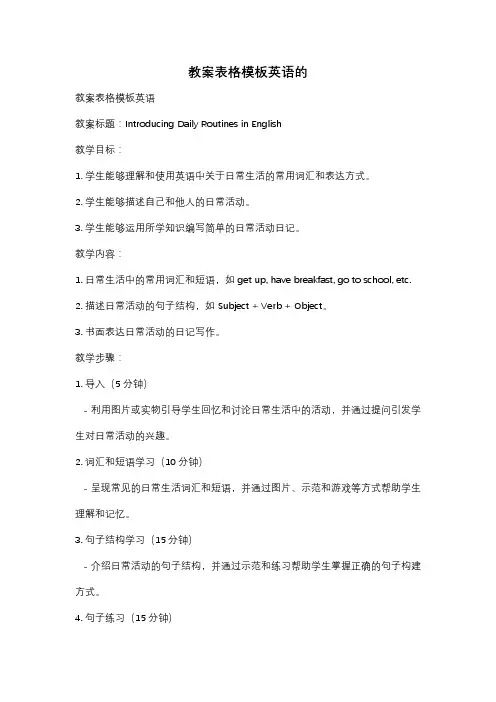
教案表格模板英语的教案表格模板英语教案标题:Introducing Daily Routines in English教学目标:1. 学生能够理解和使用英语中关于日常生活的常用词汇和表达方式。
2. 学生能够描述自己和他人的日常活动。
3. 学生能够运用所学知识编写简单的日常活动日记。
教学内容:1. 日常生活中的常用词汇和短语,如get up, have breakfast, go to school, etc.2. 描述日常活动的句子结构,如Subject + Verb + Object。
3. 书面表达日常活动的日记写作。
教学步骤:1. 导入(5分钟)- 利用图片或实物引导学生回忆和讨论日常生活中的活动,并通过提问引发学生对日常活动的兴趣。
2. 词汇和短语学习(10分钟)- 呈现常见的日常生活词汇和短语,并通过图片、示范和游戏等方式帮助学生理解和记忆。
3. 句子结构学习(15分钟)- 介绍日常活动的句子结构,并通过示范和练习帮助学生掌握正确的句子构建方式。
4. 句子练习(15分钟)- 学生分组进行对话练习,使用所学的句子描述自己和他人的日常活动。
5. 日记写作(15分钟)- 引导学生用所学的知识编写一篇简单的日常活动日记,鼓励他们使用多样的句子结构和词汇。
6. 总结和反馈(5分钟)- 回顾本节课所学内容,并与学生一起总结学习到的知识和技能。
教学资源:- 图片或实物- 教学PPT或黑板- 练习题和活动材料- 学生笔记本和纸张评估方式:- 观察学生在课堂上的参与和表现。
- 检查学生完成的练习题和日记写作。
- 提供反馈和指导。
教学延伸:- 鼓励学生在日常生活中使用英语描述自己的活动,并与同学分享。
- 给学生提供更多的日常活动词汇和句子结构练习。
- 引导学生扩展写作能力,编写更长、更详细的日常活动日记。
注:以上教案表格模板仅供参考,具体教案内容和步骤可根据实际教学需要进行调整和修改。

新人教版五年级英语上册教案(表格版) Unit 1: Hello!Lesson 1: GreetingsTeacher's Notes- Begin the lesson by teaching students basic greeting words such as 'hello', 'good morning', 'good afternoon', and 'goodbye'.- Model and practice the greetings in a whole-class setting.- Students will then participate in pairs to practice greeting each other using the new vocabulary.- Introduce personal information sentences such as "My name is ___" and "I am ___ years old" to allow students to share basic information about themselves.- Encourage students to take turns introducing themselves to the class using the new sentences and vocabulary learned.- Provide positive feedback and corrections when necessary.Materials Needed- Flashcards with greetings vocabulary- Dialogue practice worksheet- Personal information sentence promptsLesson 2: NumbersTeacher's Notes- Begin the lesson by introducing numbers 1-10 using visual aids such as flashcards or posters.- Model and practice counting from 1 to 10 as a whole class.- Students will then participate in counting exercises individually or in small groups.- Engage students in questioning and answering activities, encouraging them to use the new vocabulary and sentence structure.- Provide positive feedback and corrections when necessary.Materials Needed- Flashcards with numbers 1-10- Counting exercises worksheet- Objects for counting practiceLesson 3: ColorsTeacher's Notes- Begin the lesson by introducing basic colors to the students using visual aids such as flashcards or real objects.- Model and practice saying the colors as a whole class.- Students will then participate in describing objects by their colors, using sentence structures like "The ____ is ____" or "It's ____".- Engage students in a color display activity, where they create a visual representation of different colors using colored paper or art supplies.- Encourage students to share their color displays and describe the objects they have chosen.- Provide positive feedback and corrections when necessary.Materials Needed- Flashcards with colors vocabulary- Objects of different colors- Colored paper or art supplies for the color display activityLesson 4: FamilyTeacher's Notes- Begin the lesson by introducing family members vocabulary to the students, using visual aids such as flashcards or pictures.- Model and practice saying the family members' names as a whole class.- Students will then participate in describing their own family members, using sentence structures like "This is my ____" or "He/She is my ____".- Engage students in a family tree activity, where they create a visual representation of their family using pictures or drawing.- Encourage students to share their family trees and describe the family members they have included.- Provide positive feedback and corrections when necessary.Materials Needed- Flashcards with family members vocabulary- Pictures or drawings for the family tree activity- Colored pencils or markers for drawing the family treeUnit 2: School Life... (Continue with additional lessons and content based on the textbook)。
小学英语教案设计表格实用模板一、教案概述1. 教学目标:知识目标:让学生掌握基本的英语单词和句型。
能力目标:培养学生基本的英语听、说、读、写能力。
2. 教学内容:单词:hello, good morning, good afternoon, good evening, how are you, my name is, nice to meet you句型:介绍自己,询问他人,回答问候。
3. 教学重点与难点:重点:单词和句型的学习与运用。
难点:听力和口语的准确表达。
二、教学方法与手段1. 教学方法:情景教学法:通过设定情景,让学生在实际语境中学习英语。
游戏教学法:通过趣味游戏,激发学生的学习兴趣。
互动教学法:鼓励学生积极参与,提高口语表达能力。
2. 教学手段:图片、卡片:辅助教学,直观展示单词和句型。
录音机、音响:播放英语歌曲、对话,提高听力能力。
电子白板:展示教学内容,方便学生观看。
三、教学步骤1. 热身活动(5分钟):教师与学生用中文进行简单的自我介绍。
学生互相问候,熟悉课堂氛围。
2. 课程导入(10分钟):教师展示图片,引导学生说出单词。
教师示范句型,学生跟读。
3. 新课学习(15分钟):教师讲解单词和句型的用法。
学生进行小组讨论,练习口语表达。
4. 课堂练习(10分钟):学生进行听力练习,回答问题。
教师点评并纠正发音错误。
5. 总结与作业布置(5分钟):教师对本节课内容进行总结。
布置作业:抄写单词和句型,编写一个小对话。
四、课后反思1. 教师对本节课的教学效果进行自我评价。
2. 学生对本节课的学习情况进行反馈。
3. 针对不足之处,调整教学方法和完善教学内容。
五、教学评价1. 课堂表现:观察学生在课堂上的参与程度、发言积极性等。
2. 作业完成情况:检查学生作业的完成质量、单词抄写和对话编写。
3. 听力、口语测试:定期进行听力测试和口语角活动,检验学生的学习成果。
六、第二单元:日常问候与介绍1. 教学目标:知识目标:让学生掌握日常问候语和介绍自己的方式。
英语教案表格模版一、教学内容本节课选自人教版小学英语PEP教材,第六单元课题为"I can play basketball"。
本节课主要学习一般现在时态,并能用I can句型介绍自己和他人的能力。
二、教学目标1. 学生能够听懂、会说、会读I can play basketball.2. 学生能够用I can句型介绍自己和他人的能力。
3. 学生能够通过本节课的学习,提高自己的英语学习兴趣。
三、教学难点与重点重点:一般现在时态的运用,I can句型的介绍。
难点:一般现在时态的运用。
四、教具与学具准备1. 教具:PPT、篮球、足球、乒乓球等。
2. 学具:课本、练习本、文具。
五、教学过程1. 热身(5分钟)教师与学生进行简单的英语对话,引导学生进入学习状态。
2. 引入(5分钟)教师向学生展示篮球、足球、乒乓球等运动器材,引导学生用英语描述这些运动器材。
3. 呈现(10分钟)教师通过PPT呈现本节课的主要内容,引导学生学习一般现在时态和I can句型。
4. 操练(10分钟)教师组织学生进行小组活动,让学生用I can句型介绍自己和他人的能力。
5. 巩固(10分钟)教师通过PPT设计一些练习题,让学生巩固本节课所学内容。
六、板书设计1. I can play basketball.2. 一般现在时态:I can + 动词原形。
七、作业设计1. 请用I can句型介绍自己和他人的能力。
答案:I can play basketball/sing/dance.八、课后反思及拓展延伸教师在课后要对课堂进行反思,看看哪些地方做得好,哪些地方需要改进。
同时,教师还可以为学生提供一些拓展延伸的材料,让学生在家里继续学习英语。
重点和难点解析一、教学内容本节课选自人教版小学英语PEP教材,第六单元课题为"I can play basketball"。
本节课主要学习一般现在时态,并能用I can句型介绍自己和他人的能力。
七年级英语教学设计表格模板引言概述:在七年级英语教学中,教师需要进行教学设计,以确保教学内容的准确性和有效性。
为了帮助教师更好地进行教学设计,本文将提供一个七年级英语教学设计表格模板,以帮助教师系统地组织和计划教学内容。
正文内容:1. 教学目标1.1 知识目标- 确定学生需要掌握的英语词汇和语法知识。
- 设定学生需要达到的听、说、读、写的能力水平。
- 确定学生需要了解的文化知识。
1.2 能力目标- 培养学生的听力理解能力,使其能够听懂简单的英语对话和文章。
- 培养学生的口语表达能力,使其能够用简单的英语进行交流。
- 培养学生的阅读理解能力,使其能够理解简单的英语文章。
- 培养学生的写作能力,使其能够用简单的英语进行书面表达。
1.3 情感目标- 培养学生对英语学习的兴趣和积极性。
- 培养学生的合作意识和团队精神。
- 培养学生的跨文化交流能力,增强他们的国际视野。
2. 教学内容2.1 课文内容- 确定教材中需要教授的课文和相关词汇、语法知识。
- 设计听、说、读、写的练习活动,帮助学生巩固课文内容。
2.2 语法知识- 确定需要教授的基本语法知识,如时态、语态、句型等。
- 设计相关的练习活动,帮助学生掌握和运用语法知识。
2.3 词汇- 确定需要教授的基本词汇,如常用单词、短语等。
- 设计相关的练习活动,帮助学生记忆和运用词汇。
3. 教学方法3.1 情境教学法- 创造真实的情境,让学生在实际交际中学习英语。
- 利用角色扮演、情景模拟等活动,激发学生的学习兴趣。
3.2 合作学习法- 设计小组活动,让学生在合作中互相学习和帮助。
- 鼓励学生分享自己的观点和经验,促进彼此之间的学习交流。
3.3 多媒体教学法- 利用多媒体技术,如投影仪、电脑等,辅助教学。
- 使用图片、音频、视频等资源,增强学生的学习效果。
4. 教学评价4.1 课堂表现评价- 观察学生在课堂上的积极性、参与度和表现,给予及时的反馈和鼓励。
- 设计小组讨论、口语演讲等活动,评价学生的口语表达能力。
课时集体备课教案年级:_ 学科:____主备:_ _2016 年月日课时集体备课教案年级:_ 六年级学科:__英语___主备:_ _2016 年月日课时集体备课教案年级:_ 六年级学科:__英语___主备:_ _2016 年月日课时集体备课教案年级:_ 六年级学科:__英语___主备:_ _2016 年月日课时集体备课教案年级:_ 六年级学科:__英语___主备:_ _2016 年月日课时集体备课教案年级:_ 六年级学科:__英语___主备:_ _2016 年月日信息化相关基础知识习题及答案1、目前世界上最大的计算机互联网络是()。
A)ARPA网 B)IBM网 C)Internet D)Intranet答案(C)2、计算机网络的目标是实现()。
A)数据处理B)信息传输与数据处理 C)文献查询 D)资源共享与信息传输答案(D)。
3、计算机网络最突出的优点是()。
A)运算速度快 B)运算精度高 C)存储容量大 D)资源共享答案(D)。
4、在OSI参考模型的分层结构中“会话层”属第几层()。
A)1 B)3 C)5 D)7答案(C)。
5、局域网的网络软件主要包括()。
A)服务器操作系统,网络数据库管理系统和网络应用软件 B)网络操作系统,网络数据库管理系统和网络应用软件C)网络传输协议和网络应用软件 D)工作站软件和网络数据库管理系统答案(B)。
6、下列操作系统中,()不是网络操作系统。
A)OS/2 B)DOS C)Netware D)Windows NT答案(B)。
7、拥有计算机并以拨号方式接入网络的用户需要使用()。
A)CD—ROM B)鼠标 C)电话机D)Modem答案(D)。
8、下列四项中,合法的IP地址是()。
精品好文档,推荐学习交流A)210.45.233 B)202.38.64.4 C)101.3.305.77D)115,123,20,245 仅供学习与交流,如有侵权请联系网站删除谢谢11。